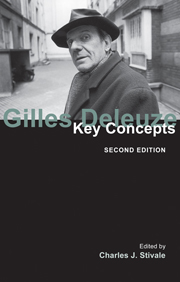Book contents
- Frontmatter
- Contents
- Contributors
- Acknowledgements
- Abbreviations
- Introduction: Gilles Deleuze, a life in friendship
- PART I PHILOSOPHIES
- PART II ENCOUNTERS
- 5 Sense, series
- 6 Event
- 7 Assemblage
- 8 Micropolitics
- 9 Becoming-woman
- 10 The minor
- 11 Style, stutter
- 12 The logic of sensation
- 13 Cinema
- Part III FOLDS
- Chronology
- Bibliography
- Index
7 - Assemblage
from PART II - ENCOUNTERS
- Frontmatter
- Contents
- Contributors
- Acknowledgements
- Abbreviations
- Introduction: Gilles Deleuze, a life in friendship
- PART I PHILOSOPHIES
- PART II ENCOUNTERS
- 5 Sense, series
- 6 Event
- 7 Assemblage
- 8 Micropolitics
- 9 Becoming-woman
- 10 The minor
- 11 Style, stutter
- 12 The logic of sensation
- 13 Cinema
- Part III FOLDS
- Chronology
- Bibliography
- Index
Summary
Assemblage, as it is used in Deleuze and Guattari's work, is a concept dealing with the play of contingency and structure, organization and change; however, we should also keep in mind that these pairs of terms are false alternatives (D: 99). The term in French is agencement, usually translated as “putting together”, “arrangement”, “laying out”, “layout” or “fitting' (Cousin et al. 1990: 9–10). It is important that agencement is not a static term; it is not the arrangement or organization but the process of arranging, organizing, fitting together. The term as it is used in Deleuze and Guattari's work is commonly translated as assemblage: that which is being assembled. An assemblage is not a set of predetermined parts (such as the pieces of a plastic model aeroplane) that are then put together in order or into an already-conceived structure (the model aeroplane). Nor is an assemblage a random collection of things, since there is a sense that an assemblage is a whole of some sort that expresses some identity and claims a territory. An assemblage is a becoming that brings elements together.
We can get a sense of the term assemblage by seeing how it is used in different contexts. In the field of geology it refers to “a group of fossils that, appearing together, characterize a particular stratum” (“Assemblage” n.d.).
- Type
- Chapter
- Information
- Gilles DeleuzeKey Concepts, pp. 91 - 102Publisher: Acumen PublishingPrint publication year: 2011

